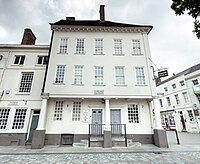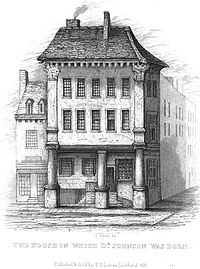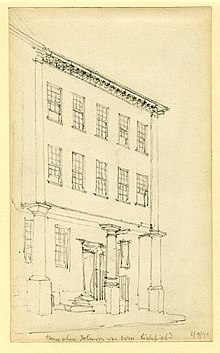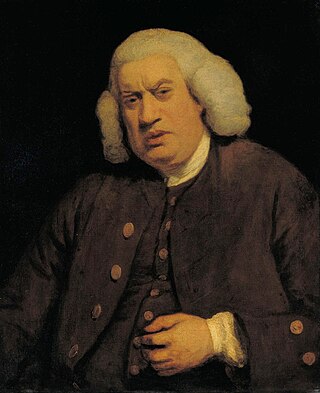
Samuel Johnson, often called Dr Johnson, was an English writer who made lasting contributions as a poet, playwright, essayist, moralist, literary critic, sermonist, biographer, editor, and lexicographer. The Oxford Dictionary of National Biography calls him "arguably the most distinguished man of letters in English history".
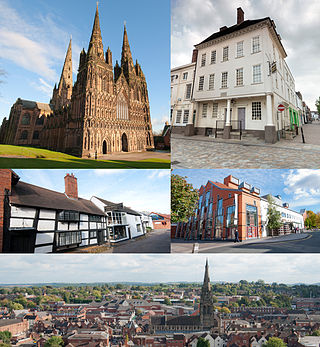
Lichfield is a cathedral city and civil parish in Staffordshire, England. Lichfield is situated 18 miles (29 km) south-east of Stafford, 9 miles (14 km) north-east of Walsall, 8 miles (13 km) north-west of Tamworth and 13 miles (21 km) south-west of Burton Upon Trent. At the time of the 2021 Census, the population was 34,738 and the population of the wider Lichfield District was 106,400.

David Garrick was an English actor, playwright, theatre manager and producer who influenced nearly all aspects of European theatrical practice throughout the 18th century, and was a pupil and friend of Samuel Johnson. He appeared in several amateur theatricals, and with his appearance in the title role of Shakespeare's Richard III, audiences and managers began to take notice.

Events from the year 1709 in Canada.

Lichfield District is a local government district in Staffordshire, England. The district is named after its largest settlement, the city of Lichfield, which is where the district council is based. The district also contains the towns of Burntwood and Fazeley, along with numerous villages and surrounding rural areas, including part of Cannock Chase, a designated Area of Outstanding Natural Beauty.

Dr Johnson's House is a writer's house museum in London in the former home of the 18th-century English writer and lexicographer Samuel Johnson. The house is a Grade I listed building.

Broad Street is a wide street in central Oxford, England, just north of the former city wall. The street is known for its bookshops, including the original Blackwell's bookshop at number 50, located here due to the University of Oxford. Among residents, the street is traditionally known as The Broad.
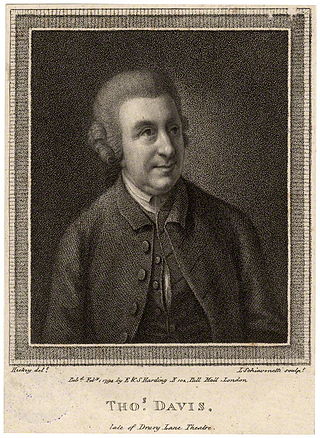
Thomas Davies was a Scottish bookseller and author. He studied at the University of Edinburgh and was for some years on the stage; but having been ridiculed by Churchill in The Rosciad he gave up acting and opened a bookshop in Covent Garden. It was here that in 1763 he introduced Boswell to Dr. Johnson, who was his close friend and to whom he dedicated his edition of the works of Massinger. He wrote a successful Life of Garrick (1780), which passed through four editions, and Dramatic Miscellanies.
King Edward VI School, Lichfield, is a co-educational secondary school and sixth form located near the heart of the city of Lichfield, Staffordshire, England. It is a community school maintained by Staffordshire Education Authority and admits pupils from the age of 11, with most electing to continue their education into the sixth form, leaving at 18. In the main school, the published admissions number is 250 pupils for each year group. In total there are in excess of 1600 pupils on roll.

Francis Barber, born Quashey, was the Jamaican manservant of Samuel Johnson in London from 1752 until Johnson's death in 1784. Johnson made him his residual heir, with £70 a year to be given him by Trustees, expressing the wish that he move from London to Lichfield, Staffordshire, Johnson's native city. After Johnson's death, Barber did this, opening a draper's shop and marrying a local woman. Barber was also bequeathed Johnson's books and papers, and a gold watch. In later years he had acted as Johnson's assistant in revising his famous Dictionary of the English Language and other works. Barber was also an important source for James Boswell concerning Johnson's life in the years before Boswell himself knew Johnson.

Levett is a surname of Anglo-Norman origin, deriving from [de] Livet, which is held particularly by families and individuals resident in England and British Commonwealth territories.
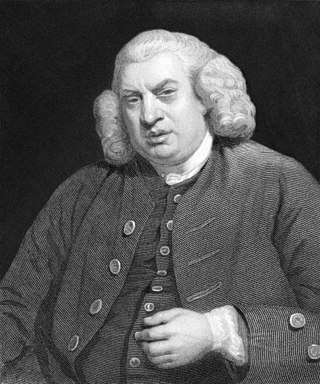
Robert Levet (1705–1782), a Yorkshireman who became a Parisian waiter, then garnered some training as an apothecary and moved to London, was eulogised by the poet Samuel Johnson, with whom Levet shared a friendship of thirty-six years, in Johnson's poem "On the Death of Dr. Robert Levet."

Irene is a Neoclassical tragedy written between 1726 and 1749 by Samuel Johnson. It has the distinction of being the work Johnson considered his greatest failure. Since his death, the critical consensus has been that he was right to think so.

Samuel Johnson was an English author born in Lichfield, Staffordshire. He was a sickly infant who early on began to exhibit the tics that would influence how people viewed him in his later years. From childhood he displayed great intelligence and an eagerness for learning, but his early years were dominated by his family's financial strain and his efforts to establish himself as a school teacher.
Theophilus Levett (1693–1746) was an attorney and early town clerk of Lichfield, Staffordshire, a prominent Staffordshire politician and landowner, and a member of a thriving Lichfield social and intellectual circle which included his friends Samuel Johnson, the physician Erasmus Darwin, the writer Anna Seward and the actor David Garrick, among others.

St Mary's Church is a city centre church in Lichfield, Staffordshire England located on the south side of the market square. A church is reputed to have been on the present site since at least 1150 but the current building dates from 1870 and is a Grade II* listed building. The church was remodelled in the early 1980s and again in 1997-1999 and now serves a variety of purposes including Lichfield Library and Tourist Information on the ground floor, and on the top floor, The Hub at St Mary's is now home to a speciality coffee shop, art gallery, treasury exhibition and performing arts space.

Richard Greene (1716–1793), was an English antiquary and collector of curiosities.
Gilbert Walmisley or Walmesley (1680–1751) was an English barrister, known as a friend of Samuel Johnson.
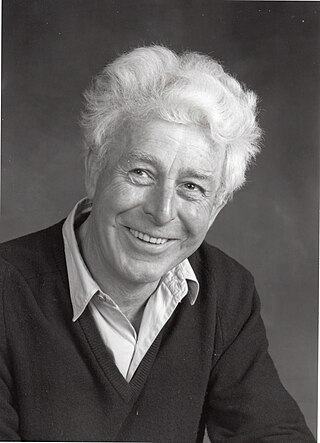
Denis Alva Parsons, MBE, ARBS, was an English sculptor and carver in wood and stone, working in the tradition of "direct carving" technique and figurative bronzes.

According to Queeney is a 2001 Booker-longlisted biographical novel by English writer Beryl Bainbridge. It concerns the last years of Samuel Johnson and his relationship between Hester Thrale and her daughter 'Queeney'. The bulk of the novel is set between 1765 and his death in 1784, with the exception of the correspondence from H. M. Thrale (Queeney) to Laetitia Hawkins from 1807 onwards, at the end of the chapters.
